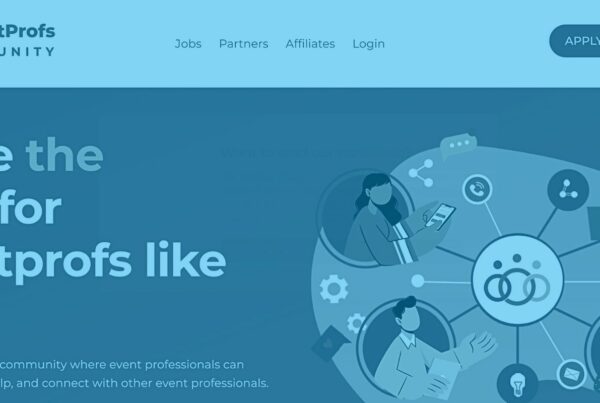Augmented Reality (AR) has the potential to revolutionize how we live our lives, but are we there yet? Will and Brandt are excited to see just how revolutionary AR will be for events.
In today’s episode, Will Curran and Brandt Krueger discuss AR for Events. Together, they explore how AR for events can reshape how people interact with each other and their venues. Looking past flashy screen-based AR, Will and Brandt focus on what they hope to see, issues that may arise, and what might be around the corner in AR tech.
AR Can Enhance Instant Translation
Will kicks off today’s topic by taking us back to Google’s 2022 IO conference. “Exciting news for me was the augmented reality glasses that offer Google translate. They’re planning on doing a Google Glass level translation, where it’s not only a verbal translation but it’s also showing text on your glasses of what the other person is saying,” he explains.
“Right now, a lot of our clients have been dumping money into translation but imagine if everybody had this already,” continues Will. “If Google can make a product where there is text showing at the bottom, I think we’re a short 2 or 3 years away from this being mainstream.”
Brandt adds that Google is excellent at showing potential for products in the future. “Even going back to Google Glass, you could really see the potential,” he says. “I remember stopping at a booth at an earlier IMEX event, and they were showing how you could use Google Glass to see comments coming in. That was one of the first real events uses I saw. It sparked my mindset.”
Navigation and Wayfinding with AR
Seeing how Google Glass used AR for events led Brandt to consider how we can use AR for wayfinding. “I’m thinking about being able to use that same navigation technology and apply it to a tradeshow floor,” says Brandt. “For example, if you’re currently in booth 972 and you have an appointment at booth 101, what’s the fastest way to get from here to there? We can see where this technology could apply to events.”
AR also allows you to add value beyond simple navigation. “Having the ability to pop up things that aren’t there, like lookout spots or interesting notes about the location, creates lots of potential for wayfinding, sightseeing, fun facts, trivia, and digital scavenger hunts,” adds Brandt.
Using AR Can Improve the Speaker-Audience Relationship
AR for events can also significantly change how presenters and event planners communicate with attendees.
“How do you truly connect with virtual and in-person audiences?” asks Will. “AR would be a huge leap forward. One of the biggest issues for a presenter trying to view comments is having to either look at a downstage monitor or hold an iPad in your arm. One takes your eye contact away and the other is the most awkward thing ever,” he says. AR could remove those challenges while enhancing audience participation.
“I’m also thinking about the flip side where the audience can see those comments while still participating. I’m thinking about those kinds of connections that subtly remind you there is a virtual audience,” continues Will. “The AR would allow there to be that visualization of that audience.”
AR Can Help Planners and Venues
Branching off from visualizing audiences, Brandt steers us toward visualizing actual venues. “I think about site visits,” he says. “In addition to getting the physical tour, wouldn’t it be great to see what the venue looks like set up in theatre style, in rounds, or to drop in your actual design in the blink of an eye? Being able to do that before you set it all up will be a huge timesaver and selling point for the venue.”
Brandt continues: “Being an AV nerd, I want to know where all the power drops and rigging points are. Being able to have that overlay is where a lot of the real power of AR is. Everybody gets so caught up in virtual reality but there is so much power in layering over reality that I think will really blow people’s minds when it comes into effect.”
Communication and Networking
Moving onto the next topic, Will mentions the massive potential for new communication methods that AR brings to the events industry.
Brandt offers an example from an IMEX event two years ago, “Virtual Help Desk was showing off personalization technology where, depending on how you answered questions at registration, it showed different things on the screen.” This kind of integration gives each attendee a uniquely customized experience.
“I was also thinking about how AR changes networking too,” adds Will. “If we get to the point where the data is secure enough, imagine that I could look at Brandt, and instead of having a badge that says ‘Brandt’, all his information pops up. You can fit way more information in that than on a badge.”
Brandt agrees but emphasizes the privacy concerns around that kind of technology. “It’s going to take a while. Not because of technology but because of societal norms. I can’t wait for that to happen, but I know we’re going to have to figure it out.”
Apple Headset Rumors
There are rumors Apple is working on virtual and augmented reality technology. As the tech duo wrap up the episode, Brandt shifts from Google to Apple. “Let’s say that Apple announces a headset. What’s going to be the app that makes you want it?” asks Brandt.
Brandt offers his thoughts first, as Will thinks about the question. “I honestly don’t think they’ll know,” Brandt says. “I think back to the Apple watch, and when they first brought it out it was the everything device. When they got about a year into it they went, ‘oh, fitness.’ I think the headset will come out as the everything device and at some point, they’ll figure out what it’s for.”
Will agrees, “You’re 100% right. I do think they need a camera for it to become truly revolutionary and not just become a second screen. In that case, I think the future would be the ability to bring in renderings of people like memojis.”
Conclusive Thoughts
“We didn’t even touch on the other forms of augmented reality. We get so locked in on the visual that it’s easy to forget the other forms of augmented reality like layering over audio, instant translation, and even sensation augmented reality,” says Brandt. “It’s an exciting time. I can’t wait to see where this technology goes over the next 5-10 years.”
Will leaves listeners with one final thought: “It’ll be up to the event professionals to implement it. Don’t be the event professional that waits 10 years to implement it. Hopefully, you’ll implement it right away and we can see this make some big changes in the event industry.”
We’d love to hear what you think! What do you think AR for events will look like in 5 or 10 years? Shoot us an email. We’d love to hear from you. We read every single one of your emails.








